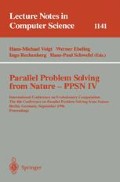Abstract
In this paper we introduce two macro-level operators to enhance the use of population-based evolutionary computing techniques in multiagent environments: speciation and symbiogenesis. We describe their use in conjunction with the genetic algorithm to evolve Pittsburgh-style classifier systems, where each classifier system represents an agent in a cooperative multi-agent system. The reasons for implementing these kinds of operators are discussed and we then examine their performance in developing a controller for the gait of a wall-climbing quadrupedal robot, where each leg of the quadruped is controlled by a classifier system. We find that the use of such operators can give improved performance over static population/agent configurations.
Preview
Unable to display preview. Download preview PDF.
References
Allee W C, Emerson A E, Schmidt K P, Park T & Park O (1949), “Principles of Animal Ecology”, Saunders Company.
Bull L & Fogarty T C (1994), “Evolving Cooperative Communicating Classifier Systems”, Third Conference on Evolutionary Programming, World Scientific.
Bull L, Fogarty T C, & Pipe A G (1995), “Artificial Endosymbiosis”, Proceedings of the Third European Conference on Artificial Life, Springer-Verlag, pp273–289.
Cohoon J P, Hegde S U, Martin W N & Richards D (1987), “Punctuated Equilibria; A Parallel Genetic Algorithm”, Proceedings of the Second International Conference on Genetic Algorithms, Lawrence Erlbaum Associates, pp148–154.
Cruse H, Muller-Wilm U & Dean J (1992), “Artificial Neural Nets for Controlling a 6-legged Walking System”, Animals to Animats 2, MIT Press.
Dawkins R (1995), “River Out of Eden”, Weidenfeld & Nicholson.
Holland J H (1975), “Adaption in Natural and Artificial Systems”, Univ. of Michigan Press, Ann Arbor.
Kauffman S A (1993), “The Origins of Order: Self-organisation and Selection in Evolution”, Oxford University Press.
Margulis L (1970), “Origin of Eukaryotic Cells”, Yale University Press.
Mayr E (1942), “Systematics and the Origin of Species”, Columbia Press, New York.
Merezhkovsky (1920) in Khakhina L N (1992), “Concepts of Symbiogenesis: History of Symbiogenesis as an Evolutionary Mechanism”, Yale University Press.
Nardon P & Grenier M (1991), “Serial Endosymbiosis Theory and Weevil Evolution: The Role of Symbiosis”, Symbiosis as a Source of Evolutionary Innovation, MIT Press, pp155–169.
Rosen R (1994), “Cooperation and Chimera”, Cooperation and Conflict in General Evolutionary Processes, John Wiley & Sons, pp 343–358.
Smith S F (1980), “A Learning System Based on Genetic Adaptive Algorithms”, PhD Dissertation, University of Pittsburgh.
Author information
Authors and Affiliations
Editor information
Rights and permissions
Copyright information
© 1996 Springer-Verlag Berlin Heidelberg
About this paper
Cite this paper
Bull, L., Fogarty, T.C. (1996). Evolutionary computing in multi-agent environments: Speciation and symbiogenesis. In: Voigt, HM., Ebeling, W., Rechenberg, I., Schwefel, HP. (eds) Parallel Problem Solving from Nature — PPSN IV. PPSN 1996. Lecture Notes in Computer Science, vol 1141. Springer, Berlin, Heidelberg. https://doi.org/10.1007/3-540-61723-X_965
Download citation
DOI: https://doi.org/10.1007/3-540-61723-X_965
Published:
Publisher Name: Springer, Berlin, Heidelberg
Print ISBN: 978-3-540-61723-5
Online ISBN: 978-3-540-70668-7
eBook Packages: Springer Book Archive

